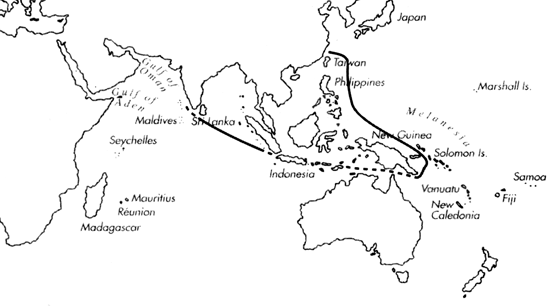Range: Bay of Bengal to Papua New Guinea, Philippines and Taiwan.
Description: Moderately small to medium-sized, moderately light to solid. Last whorl conical, sometimes ventricosely conical; outline slightly convex at adapical third to half, straight below. Shoulder angulate. Spire low to high, outline concave to deeply concave. Larval shell of about 3.5 whorls, maximum diameter 0.8 mm. Teleoconch sutural ramps flat to slightly concave, with 1 increasing to 3-5 spiral grooves; grooves weaker and finer on latest ramps. Basal half of last whorl with variably spaced punctate spiral grooves separating ribs anteriorly and a few ribbons posteriorly.
| Shell Morphometry | ||
|---|---|---|
| L | 30-58 mm | |
| RW | 0.08-0.40 g/mm | |
| RD | 0.60-0.68 | |
| PMD | 0.82-0.94 | |
| RSH | 0.08-0.26 | |
Ground colour white. Last whorl with a broad, continuous or interrupted brown spiral band on each side of centre; often brown axial flames extend from posterior brown band to shoulder ramp. Some specimens with dashed darker brown spiral lines within and spiral rows of brown dots outside the colour bands; dots vary in number and arrangement. Pattern varies from largely white shells sparsely maculated with brown to largely brown shells with narrow white bands at base, centre and shoulder. Larval whorls white to pale brown. Teleoconch sutural ramps with brown radial markings. Aperture white.
Periostracum greyish olive, thin, translucent, with fine axial ridges.
Habitat and Habits: In 20-100 m; east of Madras, C. eximius was collected in 45 m on mud bottom (Kohn, 1978a).
Discussion: C. eximius is most similar to C. lentiginosus, C. malacanus and C. lenavati; for comparison see the DISCUSSIONS of those species. C. lischkeanus resembles C. eximius in shape but differs in its less concave spire outline, often more prominent spiral sculpture on the late sutural ramps, either prominently tufted or smooth but thick and opaque periostracum, and in the absence of brown axial flames from the adapical part of its last whorl.

C. eximius range map
This section contains verbatim reproductions of the accounts of 316 species of Conus from the Indo-Pacific region, from Manual of the Living Conidae, by Röckel, Korn and Kohn (1995). They are reproduced with the kind permission of the present publisher, Conchbooks.
All plates and figures referred to in the text are also in Röckel, Korn & Kohn, 1995. Manual of the Living Conidae Vol. 1: Indo-Pacific Region.
The range maps have been modified so that each species account has it own map, rather than one map that showed the ranges of several species in the original work. This was necessary because each species account is on a separate page on the website and not confined to the order of accounts in the book.